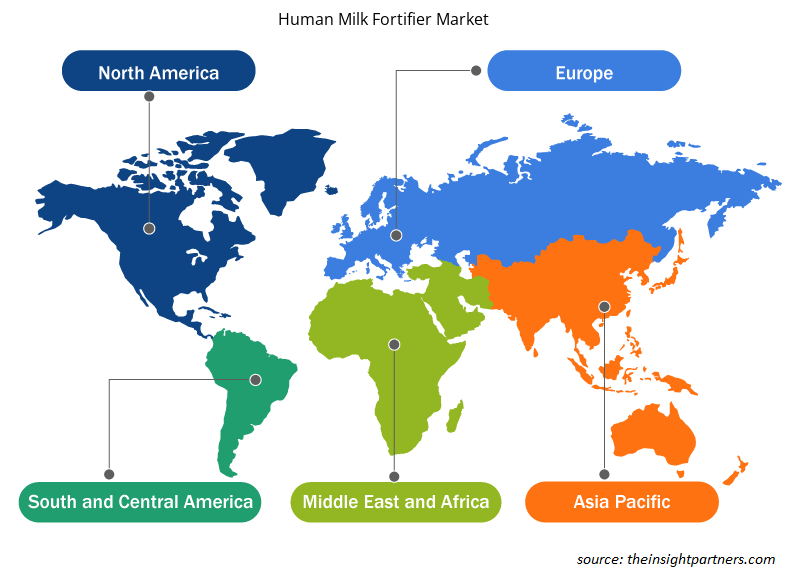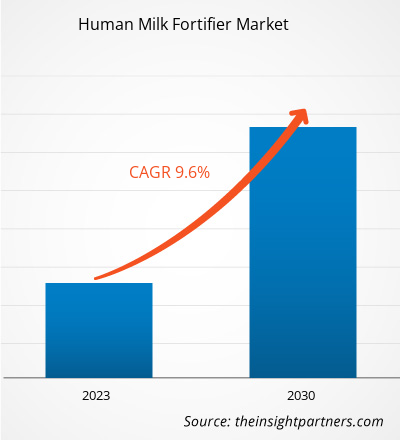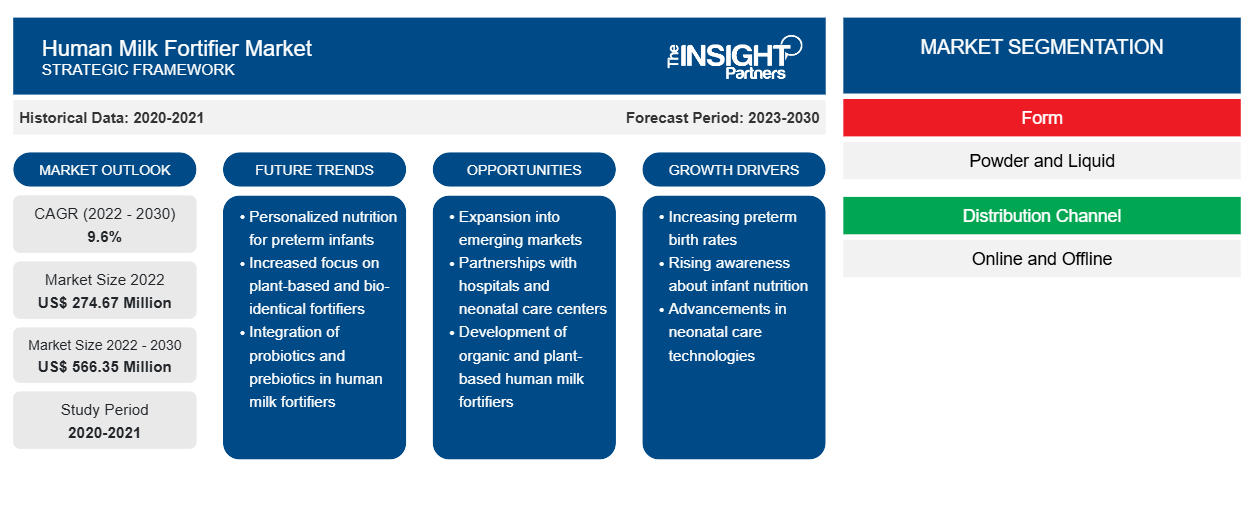[Informe de investigación] Se espera que el tamaño del mercado de fortificantes de leche humana crezca de US$ 274,67 millones en 2022 a US$ 566,35 millones en 2030; se estima que registrará una CAGR del 9,6% entre 2023 y 2030.
Perspectivas del mercado y opinión de analistas:
Los fortificantes de la leche materna son suplementos nutricionales que se añaden a la leche materna para aportar calorías, electrolitos y vitaminas adicionales a los bebés. Se recetan habitualmente a los bebés prematuros en la unidad de cuidados intensivos neonatales (UCIN) para garantizar la ingesta nutricional y mejorar el desarrollo y el crecimiento generales. Además, a los bebés con bajo peso también se les recetan fortificantes de la leche materna.
Factores impulsores del crecimiento y desafíos:
En los últimos años, el número de nacimientos prematuros ha aumentado debido a los cambios en los estilos de vida y a enfermedades crónicas como la diabetes y la hipertensión arterial. Según los Centros para el Control y la Prevención de Enfermedades (CDC), en 2021, el nacimiento prematuro afectó a aproximadamente 1 de cada diez bebés nacidos en los EE. UU. La tasa de nacimientos prematuros en los EE. UU. aumentó del 10,1 % en 2020 al 10,5 % en 2021. La Organización Mundial de la Salud (OMS) estimó que nacieron aproximadamente 13,4 millones de bebés en 2020. La complicación del nacimiento prematuro es la principal causa de muerte entre los niños menores de cinco años, responsable de aproximadamente 900 000 muertes en 2019. Los bebés prematuros pueden tener problemas respiratorios, dificultades de alimentación, retrasos en el desarrollo, parálisis cerebral y problemas de visión y audición.
El creciente número de nacimientos prematuros ha aumentado la demanda de fortificantes de la leche materna para el crecimiento y desarrollo adecuados de los bebés. Muchos bebés prematuros necesitan que se añadan nutrientes adicionales a la leche de su madre. A menudo necesitan proteínas, calcio, fósforo y sal adicionales para desarrollar huesos fuertes y órganos sanos. Los fortificantes de la leche materna ayudan a proporcionar estos nutrientes adicionales a los bebés. En los fortificantes de la leche materna, se añaden nutrientes adicionales a la leche antes de dársela a los bebés. Por lo tanto, un aumento en los nacimientos prematuros refuerza el crecimiento del mercado de fortificantes de la leche materna .
Los gobiernos han impuesto diversas normas y reglamentos relacionados con la fabricación y el uso de fortificantes de la leche materna para garantizar la seguridad de los recién nacidos y mantener los estándares de calidad del producto. En Canadá, los fortificantes de la leche materna están regulados por el Reglamento sobre Alimentos y Medicamentos (FDR). La regla del FDR, Parte B, División 25 (B.25.019) se implementa para garantizar la venta adecuada de fortificantes de la leche materna bajo la supervisión médica adecuada. Además, el fortificante de la leche materna debe proporcionar a Health Canada una presentación previa a la comercialización. La sección B.25.011, subsecciones (a) a (n), especifica los requisitos reglamentarios para un nuevo fortificante de la leche materna. En los EE. UU., el fortificante de la leche materna se clasifica como fórmula infantil exenta; sin embargo, los fabricantes deben cumplir con los requisitos de la Administración de Alimentos y Medicamentos de los EE. UU. (FDA), que garantiza la declaración de nutrientes, incluida la cantidad de cada mineral y vitamina que se enumera en los anexos del producto. La implementación de dichas regulaciones ha obstaculizado la fabricación de fortificantes de la leche materna, lo que restringe el crecimiento del mercado.
Personalice este informe según sus necesidades
Obtendrá personalización en cualquier informe, sin cargo, incluidas partes de este informe o análisis a nivel de país, paquete de datos de Excel, así como también grandes ofertas y descuentos para empresas emergentes y universidades.
-
Obtenga las principales tendencias clave del mercado de este informe.Esta muestra GRATUITA incluirá análisis de datos, desde tendencias del mercado hasta estimaciones y pronósticos.
Segmentación y alcance del informe:
El mercado mundial de fortificantes de leche humana está segmentado por forma, canal de distribución y geografía. El mercado de fortificantes de leche humana está segmentado en polvo y líquido según la forma. El mercado de fortificantes de leche humana se clasifica en línea y fuera de línea según los canales de distribución. El mercado mundial de fortificantes de leche humana está ampliamente segmentado por geografía en América del Norte, Europa, Asia Pacífico, Oriente Medio y África, y América del Sur y Central.
Análisis segmental:
Según la forma, el mercado de fortificantes de leche humana se segmenta en polvo y líquido. Se espera que el segmento de polvo registre una CAGR más alta durante el período de pronóstico. Los fortificantes de leche humana en forma de polvo complementan y mejoran el contenido nutricional de la leche materna. La leche materna fortificada se prescribe a bebés prematuros o médicamente frágiles. Las personas prefieren los fortificantes de leche humana en polvo por su comodidad en el almacenamiento, manipulación y preparación. Además, son más fáciles de almacenar y transportar y garantizan una vida útil más larga que los productos líquidos.
Según el canal de distribución, el mercado de fortificadores de leche humana se clasifica en en línea y fuera de línea. Se prevé que el segmento en línea registre una CAGR más alta durante el período de pronóstico. Las tiendas minoristas en línea están asociadas con la comodidad de comprar desde la comodidad del hogar. Los padres pueden buscar y comprar fortificadores de leche humana en cualquier momento que les convenga sin visitar una tienda. Además, las plataformas en línea a menudo les brindan acceso a una amplia gama de fortificadores, lo que permite a los padres explorar varias opciones y elegir el producto más adecuado. Además, los fortificadores de leche humana pueden no estar disponibles en tiendas locales o especializadas; las tiendas en línea brindan acceso a un inventario más amplio, lo que facilita que los consumidores encuentren marcas específicas que no están disponibles en su localidad. Las reseñas de los clientes y la información detallada del producto ayudan aún más a los padres a tomar decisiones más informadas. Al leer reseñas de otros padres que han usado el producto, pueden obtener información sobre su efectividad e idoneidad. Los minoristas en línea con frecuencia ofrecen precios competitivos debido a los menores costos generales que las tiendas físicas. Esto puede beneficiar a los usuarios que buscan opciones económicas o comparan precios entre diferentes vendedores. Además, algunos usuarios pueden preferir comprar fortificantes de leche materna de forma discreta porque les preocupa hablar públicamente sobre la salud de su bebé. Los canales en línea ofrecen privacidad y permiten realizar compras y entregas discretas.
Análisis regional:
Según la geografía, el mercado de la harina de arroz se divide en cinco regiones clave: América del Norte, Europa, Asia Pacífico, América del Sur y Central, y Oriente Medio y África. El mercado en América del Norte se valoró en ~US$ 85,82 millones en 2022. Se estima que Asia Pacífico registrará una CAGR de ~10,4% durante el período de pronóstico. A medida que aumentan los niveles de ingresos disponibles en Asia Pacífico, más padres pueden permitirse productos sanitarios de primera calidad, incluidos los fortificantes de la leche materna. Esto ha contribuido al crecimiento del mercado, ya que los padres están dispuestos a invertir en productos que puedan mejorar la salud y el bienestar de sus hijos. Además, la expansión de la infraestructura sanitaria, incluidas las unidades de cuidados intensivos neonatales (UCIN), en Asia Pacífico ha creado un entorno favorable para el crecimiento del mercado de fortificantes de la leche materna. Los hospitales y los centros de salud están mejor equipados para brindar atención especializada a los bebés prematuros, lo que aumenta la demanda de fortificantes de la leche materna.
Perspectivas regionales del mercado de fortificantes de leche humana
Los analistas de Insight Partners explicaron en detalle las tendencias y los factores regionales que influyen en el mercado de fortificantes de leche humana durante el período de pronóstico. Esta sección también analiza los segmentos y la geografía del mercado de fortificantes de leche humana en América del Norte, Europa, Asia Pacífico, Oriente Medio y África, y América del Sur y Central.

- Obtenga datos regionales específicos para el mercado de fortificantes de leche humana
Alcance del informe de mercado de Fortificador de leche humana
| Atributo del informe | Detalles |
|---|---|
| Tamaño del mercado en 2022 | US$ 274,67 millones |
| Tamaño del mercado en 2030 | US$ 566,35 millones |
| CAGR global (2022-2030) | 9,6% |
| Datos históricos | 2020-2021 |
| Período de pronóstico | 2023-2030 |
| Segmentos cubiertos |
Por formulario
|
| Regiones y países cubiertos |
América del norte
|
| Líderes del mercado y perfiles de empresas clave |
|
Densidad de actores del mercado de fortificantes de leche humana: comprensión de su impacto en la dinámica empresarial
El mercado de fortificantes de leche humana está creciendo rápidamente, impulsado por la creciente demanda de los usuarios finales debido a factores como la evolución de las preferencias de los consumidores, los avances tecnológicos y una mayor conciencia de los beneficios del producto. A medida que aumenta la demanda, las empresas amplían sus ofertas, innovan para satisfacer las necesidades de los consumidores y aprovechan las tendencias emergentes, lo que impulsa aún más el crecimiento del mercado.
La densidad de actores del mercado se refiere a la distribución de las empresas o firmas que operan dentro de un mercado o industria en particular. Indica cuántos competidores (actores del mercado) están presentes en un espacio de mercado determinado en relación con su tamaño o valor total de mercado.
Las principales empresas que operan en el mercado de fortificantes de leche humana son:
- Laboratorios Abbott
- NeoLacta Lifesciences Pvt Ltd
- Nestlé SA
- Prolacta Bioscience Inc
- Lead Care International Ltd
Descargo de responsabilidad : Las empresas enumeradas anteriormente no están clasificadas en ningún orden particular.

- Obtenga una descripción general de los principales actores clave del mercado de fortificadores de leche humana
Desarrollos industriales y oportunidades futuras:
A continuación se enumeran varias iniciativas adoptadas por los actores clave que operan en el mercado de fortificantes de leche humana:
- En enero de 2022, Prolacta Bioscience introdujo en Japón fortificantes de leche materna. El lanzamiento tenía como objetivo ingresar en el mercado sin explotar del país y ayudar a mejorar la salud de los recién nacidos. En noviembre de 2020, Lifeblood Milk y el Instituto de Investigación Médica y de Salud de Australia del Sur (SAHMRI) iniciaron una colaboración con CSIRO, la agencia científica nacional de Australia. La asociación tenía como objetivo desarrollar fortificantes de leche materna para mejorar la nutrición y el crecimiento de los bebés prematuros.
- En septiembre de 2021, Neolacta Lifesciences Pvt. Ltd lanzó sus productos en plataformas de comercio electrónico para garantizar la fácil disponibilidad de sus productos, como Neolacta Human Breast Milk y Neolacta MMF (Mother's Milk Fortifier), para los padres.
Impacto del Covid-19:
La pandemia de COVID-19 afectó inicialmente al mercado mundial de fortificadores de leche humana debido al cierre de las unidades de fabricación, la escasez de mano de obra, la interrupción de las cadenas de suministro y la inestabilidad financiera. La interrupción de varias industrias debido a la desaceleración económica causada por el brote de COVID-19 restringió la demanda de fortificadores de leche humana. Sin embargo, las empresas están ganando terreno a medida que se han suavizado las limitaciones impuestas anteriormente en varios países. Además, la introducción de las vacunas COVID-19 por parte de los gobiernos de diferentes países alivió la situación, lo que provocó un aumento de las actividades comerciales en todo el mundo. Varios mercados, incluido el mercado de fortificadores de leche humana, experimentaron un crecimiento después de la flexibilización de los cierres y las restricciones de movimiento.
Panorama competitivo y empresas clave:
Algunos de los actores destacados que operan en el mercado global de fortificantes de leche humana incluyen Abbott Laboratories, NeoLacta Lifesciences Pvt Ltd, Nestle SA, Prolacta Bioscience Inc, Lead Care International Ltd, Raptakos, Brett & Co Ltd, NeoKare Nutrition Ltd, Danone SA, Neolac Inc y Reckitt Benckiser Group Plc.
- Análisis histórico (2 años), año base, pronóstico (7 años) con CAGR
- Análisis PEST y FODA
- Tamaño del mercado, valor/volumen: global, regional y nacional
- Industria y panorama competitivo
- Conjunto de datos de Excel
Informes recientes
Informes relacionados
Testimonios
Razón para comprar
- Toma de decisiones informada
- Comprensión de la dinámica del mercado
- Análisis competitivo
- Información sobre clientes
- Pronósticos del mercado
- Mitigación de riesgos
- Planificación estratégica
- Justificación de la inversión
- Identificación de mercados emergentes
- Mejora de las estrategias de marketing
- Impulso de la eficiencia operativa
- Alineación con las tendencias regulatorias























 Obtenga una muestra gratuita para - Mercado de fortificantes de leche humana
Obtenga una muestra gratuita para - Mercado de fortificantes de leche humana